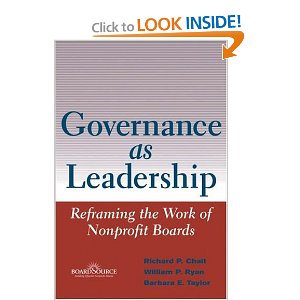 I’ve been on a board governance and board development kick lately. One of the big thought-leaders in this area is Richard Chait, who is a Professor at the Harvard Graduate School of Education and one of the authors of “Governance as Leadership: Reframing the Work of Nonprofit Boards,” and I am a big fan of his work.
I’ve been on a board governance and board development kick lately. One of the big thought-leaders in this area is Richard Chait, who is a Professor at the Harvard Graduate School of Education and one of the authors of “Governance as Leadership: Reframing the Work of Nonprofit Boards,” and I am a big fan of his work.
I recently came across a white paper published by Bader & Associates Governance Consultants in Potomac, MD. It is a simple to read two-page interview with Richard Chait about his book and the idea of generative conversations in the boardroom. I keep re-reading this white paper every few weeks, and it sparks a new thought every time I read it.
For example, I read the following passage this morning:
“Generative governance engages and challenges trustees intellectually. It’s what leaders do best. Yet most boards spend most of their time on fiduciary work, and they devote little time to the generative mode.”
In other words, boards are talking more about things like “can we afford that” and “where is the money coming from for that” and not talking about “are we being impacted by a larger trend and if so what should we do about it“.
When I read the aforementioned quote this morning, a wicked thought popped into my head, and I wondered if non-profit executive directors purposely keep their board volunteers focused on the “little picture” in an attempt to keep them out of the decision-making on the “big picture”?
 I admit that this is a cynical thought, but I just wonder . . . Hmmmmmmm?
I admit that this is a cynical thought, but I just wonder . . . Hmmmmmmm?
It is so hard to build consensus with 15 or 20 people sitting around a boardroom table. A good facilitator makes it look so easy, but it really is a gift. From what I see from many of my non-profit friends, they are hired for their fundraising and program/operations skills. I can honestly say that I’ve never worked with a search committee that said “facilitation skills” were a top skill set they were looking for in an executive director.
Is it possible that we have a dynamic where the executive director is trying to lead and it is too difficult to get the group to make big decisions on big issues; so they focus the group on tactical issues because it is easier (and important to the day-to-day functioning of the agency). When it comes time to make those big decisions, the executive director engages a few key board members who are of like mind and have influence with their peers and the decision gets made.
The net impact of this approach is widespread disengagement among board members.
OK, so here is the question this morning. Did I just wake up on the wrong side of the bed this morning and cynical thoughts are rampaging through my head. Or do you think this is likely happening in a number of non-profit organizations in your community? The better question might be “what needs to be done to fix this, and are Chait’s suggestions this right perscription?”
Please join me by taking a good hard look in the mirror this morning and share your assessment in the comment box below.
Here’s to your health!
Erik Anderson
Founder & President, The Healthy Non-Profit LLC
www.thehealthynonprofit.com
erik@thehealthynonprofit.com
http://twitter.com/#!/eanderson847
http://www.facebook.com/eanderson847
http://www.linkedin.com/in/erikanderson847

Hi Erik-
I love Chait’s work and have also spent considerable time thinking about it and trying to move organizations toward developing their capacity for it. I don’t think organizations, or their leadership are intentionally avoiding it. I think, to a large degree, especially in smaller organizations, they don’t even know about it.
Most Execs do not have the benefit of advanced leadership training or Board governance training, nor do most Boards. We have to figure out a way to move the field toward governance as leadership. The alternative is having smart people in the room looking at one part of a larger something, asking one piece of a much larger question, and completely missing the opportunity to do what they intended to do – to lead, govern and affect change.
Dani
Dani … I agree with your points entirely, but that wasn’t really my question. I am wondering if some/many executive directors are purposely focusing their boards on fiduciary questions because the idea of getting EVERYONE involved in a consensus building type of generative discussion might be overwhelming. I have one organization in mind, and I actually do think senior staff muscled their board (e.g. saying “just focus on the fundraising and we got everything else covered”). I’m thinking of another organization, and I think the same thing happened because it gave that executive director the false feeling of job security. And ‘yes’, I believe it was a deliberate strategy in both cases.
Again, you’d probably say those are the exception and not the rule. If pushed, I’d probably agree with you. I’m just trying to provoke conversation. 😉
On another subject, I someone once asked me: “What if my board members aren’t smart enough to engage in generative discussions?” OK, they said it nicer than that, but that is exactly what they meant.
I wonder if you need a certain kind of smart/engaged/knowledgeable/articulate board member to pull Chait’s recommendations off? Or does everyone have something to add to a generative discussion.
After thinking about my post a little more, I think YOU were the one who turned me on to Chait’s work. THANK YOU, Dani!!!